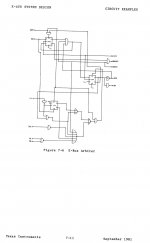I do have a bunch of the 74LS612 Memory Mappers, so that chip isn't a problem either--the problem was with the pinout of the 74LS2001, since that is the one chip I don't have sufficient info on. Many thanks for the extract of the bus arbiter logic.
Seeing all of the information that is actually out there for these has me in a major state of anticipation to read all of it! I plan to put direct scans of all of the ETI articles I have original copies of into the Cortex folder on WHTech this weekend, including a single high res scan of the component side of the board instead of in halves like the other copies I've seen.
One interesting question, the component mask numbering on mine bears absolutely no resemblance to any version described so far--almost everything is different. . .but the component positioning is the same. Any idea how that one came to be, and are there schematics that reflect this other number scheme (note it isn't the minor changes noted in either the ETI articles or the Powertran construction manual that reprinted them with some corrections)?
Once again, many thanks!


